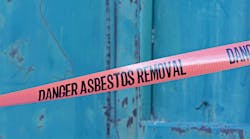What better way to celebrate Earth Day this year than to banish the top 10 indoor environmental hazards from your home? The American College of Occupational and Environmental Medicine (ACOEM)’s top 10 list of indoor environmental hazards provides a practical starting point for making your indoor environment safer and healthier.
“Earth Day reminds us of an ancient wisdom – people are inextricably linked with their environment,” said Robert K. McLellan, M.D., author of the checklist. “The environment does not stop at the walls of our homes and buildings.”
The checklist is part of ACOEM’s ongoing commitment to protect the health and safety of workers, workplaces and environments. It provides tips on how to avoid and/or control these hazards in the home and includes recommendations and helpful resources from EPA and the U.S. Consumer Product Safety Commission, among others.
ACOEM’s checklist of list of Ten Environmental Hazards You Can Live Without includes:
1. Tobacco smoke. “Long-term exposure to other people’s tobacco smoke increases risks for lung cancer, respiratory diseases and infections, heart attack, and many childhood diseases,” the ACOEM list explains. Don’t allow anyone to smoke in your home.
2. Radon. Test your home for this odorless, invisible gas that increases the risk of lung cancer.
3. Asbestos. “Asbestos was commonly used as an insulating material in homes built from 1920 to 1978,” the list explains. “Exposure to small amounts of asbestos is unlikely to cause problems, but breathing high levels increases risks of cancer and lung disease.” Identify but avoid disturbing asbestos in your home or place of work; only specially trained contractors should remove it.
4. Lead. Children are especially susceptible to lead poisoning. If you live in a home built prior to 1978, test for lead paint and only allow licensed and trained professional to remediate lead in your home.
5. Combustion gases. “Combustion gases include carbon monoxide, nitrogen oxides, and sulfur dioxide,” states ACOEM’s list. “These gases can cause flu-like symptoms, respiratory illnesses, or death.” Do not use unvented combustion appliances indoors; use an exhaust hood over a gas stove; and clean and maintain your chimneys and furnace annually.
6. Tap water. “Americans benefit from one of the safest water supplies in the world, but problems may occur. You can take a few extra measures to assure your tap water is clean.” If you use a well, test your water annually. To minimize possible lead exposure in older plumbing systems, let the water run until it’s cold before drinking or cooking with it.
7. Household chemicals. Keep household chemicals out of reach of children and pets; follow label instructions carefully; dispose of chemicals properly; and call the Poison Control Center at 1-800-222-1222 if a suspected poisoning occurs.
8. Pesticides. While not an "indoor" hazard, pesticide use around your home can impact health. Maintain your yard and garden to naturally deter pests instead of using pesticides when possible; store firewood away from the home to avoid wood-destroying insects; and follow instructions and where appropriate PPE when using pesticides.
9. Allergens. “Porous, water-damaged materials frequently grow molds and other organisms that can exacerbate allergies or other illnesses.” Fix leaks or moisture issues; brush pets outside; and wrap mattresses and pillows in allergy-proof covers.
10. Food poisoning. Keep your refrigerator temperature below 40 degrees F; wash cutting boards with soap and hot water after each use; do not allow raw meat, poultry or fish to come into contact with other food; and be aware that some fish contain chemicals or infectious agents.
ACOEM encourages the public to implement the recommendations to improve and protect their living environment. Download ACOEM’s PDF containing more information about these 10 indoor environmental hazards.

